Forest School and Children's Communication and Language Development
Added on 2023-01-11
25 Pages10469 Words1 Views
Level 6 Research Module Plan (859/837)
Topic/Subject Area
Forest School
INTRODUCTION
Forest School is a popular form of learning in primary schools in England. However,
school sessions are led by qualified and trained staff in aspects of child development. Forest
schools are nature-based learning environment. This can impact on children positively for
lifelong. This will support children to increase their experiences through hands -on learning in a
natural environment. They cover the Early Years Foundation Stage (EYFS) guidelines as well
through everyday interactions with the real world around them. Forest schools provide a new
dimension to teaching and learning. They, allow children to improve communication and
language, they would not learn in a classroom setting.
Aim
To investigate how forest school can support children’s communication and language
development.
Objectives.
1. To identify the impact of forests school on children learning.
2. To critically review the literature surrounding children’s communication and language
development.
3. To analyse the forest school practice and its impact on language and communication.
4. To draw a conclusive result based on the arguments and make the possible
recommendations.
Rationale:
Forest schools are becoming more popular and beneficial for children in England because they
allow children to develop communication and language skills as well as confidence and self-
esteem through different practical activities (Knight, 2013). Various pieces of literature have
Topic/Subject Area
Forest School
INTRODUCTION
Forest School is a popular form of learning in primary schools in England. However,
school sessions are led by qualified and trained staff in aspects of child development. Forest
schools are nature-based learning environment. This can impact on children positively for
lifelong. This will support children to increase their experiences through hands -on learning in a
natural environment. They cover the Early Years Foundation Stage (EYFS) guidelines as well
through everyday interactions with the real world around them. Forest schools provide a new
dimension to teaching and learning. They, allow children to improve communication and
language, they would not learn in a classroom setting.
Aim
To investigate how forest school can support children’s communication and language
development.
Objectives.
1. To identify the impact of forests school on children learning.
2. To critically review the literature surrounding children’s communication and language
development.
3. To analyse the forest school practice and its impact on language and communication.
4. To draw a conclusive result based on the arguments and make the possible
recommendations.
Rationale:
Forest schools are becoming more popular and beneficial for children in England because they
allow children to develop communication and language skills as well as confidence and self-
esteem through different practical activities (Knight, 2013). Various pieces of literature have
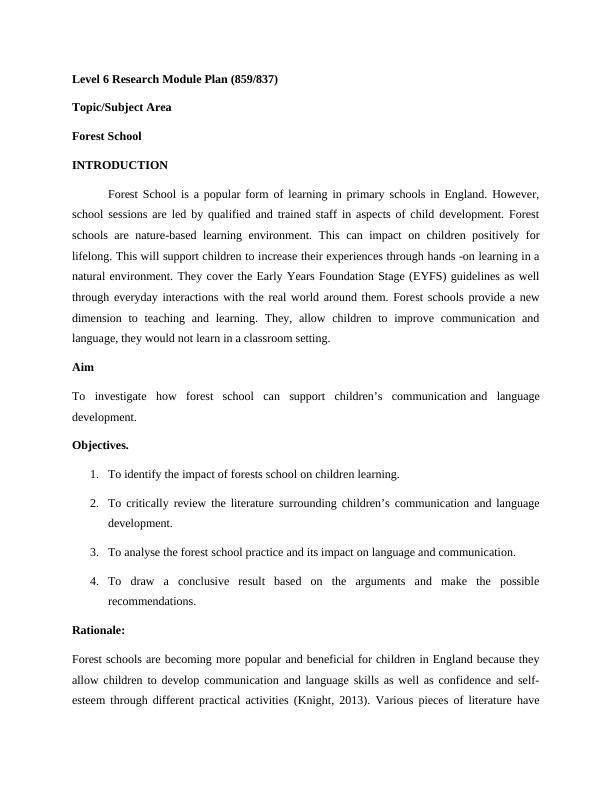
been published in different time scales regarding the role of forest schools in children’s
communication and language development with different opinions and arguments (Harris, 2017).
Forest School is becoming increasingly popular in the UK and globally, but little is known about
its effects on learning for children or how alternative methods inform learning in traditional
settings (Coates and Pimlott‐Wilson, 2018). There will be an ongoing debate on the Forest
School approach towards children’s communication and language and overall learning during
Forest School (Leather, 2018).
This research had to be given life-based experiences to children as the children learning
and education should be based on nature and education both (Knight, 2011). Following research
shows that young children learn best from the experience by consciously rather than passively
using their senses and it is from these interactions learning remain with us into adulthood. So, by
doing these children can get the chance to explore their surrounding while getting the
knowledges towards their development (Turtle, et al., 2015). On the other hand, mainstream
schools are based on teacher-led learning or technology based, so this does not allow the child to
understand about the natural materials as they are busy learning about books topic or digital
learning and children do not get a chance to go outside the classroom to explore their
surroundings (Cummings, et al., 2010). Also, the other reason, mainstream schools’ teachers are
not allowing children to go outside is that they do not want them to make their hands dirty or
clothes due to parent’s pressure, as parents do not want their children to get dirty (Cummings, et
al., 2010). While forest school can allow them to get their hands dirty and help them to practice
manageable task to extends children communication and language development (Duarte and
Freeman, 2017). So, the purpose of this research will be on how to promote forest school
learning as it will also make them aware of the need to care for each other and for the
environment and this help them towards their learning as this method is equally important as
mainstream school but it helps them to have natural contact with environment while gaining
educational knowledge (Duarte and Freeman, 2017). As forest school curriculum take place
outside the boundaries of four walls, without the distractions of electronic devices and
unnecessary supervision, children can explore and discover at their own speed while interacting
with the natural world (Cummings, et al., 2010).
communication and language development with different opinions and arguments (Harris, 2017).
Forest School is becoming increasingly popular in the UK and globally, but little is known about
its effects on learning for children or how alternative methods inform learning in traditional
settings (Coates and Pimlott‐Wilson, 2018). There will be an ongoing debate on the Forest
School approach towards children’s communication and language and overall learning during
Forest School (Leather, 2018).
This research had to be given life-based experiences to children as the children learning
and education should be based on nature and education both (Knight, 2011). Following research
shows that young children learn best from the experience by consciously rather than passively
using their senses and it is from these interactions learning remain with us into adulthood. So, by
doing these children can get the chance to explore their surrounding while getting the
knowledges towards their development (Turtle, et al., 2015). On the other hand, mainstream
schools are based on teacher-led learning or technology based, so this does not allow the child to
understand about the natural materials as they are busy learning about books topic or digital
learning and children do not get a chance to go outside the classroom to explore their
surroundings (Cummings, et al., 2010). Also, the other reason, mainstream schools’ teachers are
not allowing children to go outside is that they do not want them to make their hands dirty or
clothes due to parent’s pressure, as parents do not want their children to get dirty (Cummings, et
al., 2010). While forest school can allow them to get their hands dirty and help them to practice
manageable task to extends children communication and language development (Duarte and
Freeman, 2017). So, the purpose of this research will be on how to promote forest school
learning as it will also make them aware of the need to care for each other and for the
environment and this help them towards their learning as this method is equally important as
mainstream school but it helps them to have natural contact with environment while gaining
educational knowledge (Duarte and Freeman, 2017). As forest school curriculum take place
outside the boundaries of four walls, without the distractions of electronic devices and
unnecessary supervision, children can explore and discover at their own speed while interacting
with the natural world (Cummings, et al., 2010).
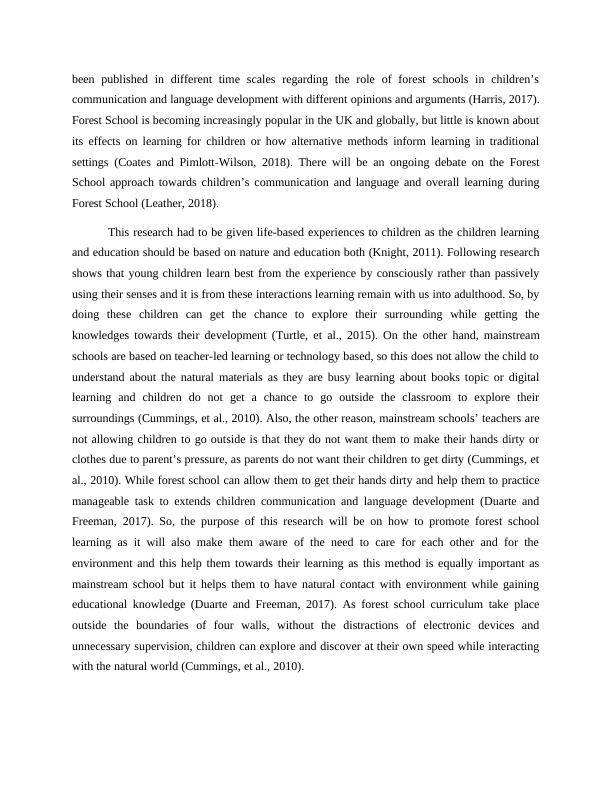
This research was carried out to evaluate the awareness of forest school. The results of this
research highlighted the value of forest schools to children and provided ample evidence that
forest schools improve the academic, communication and language of children when attended for
a long time (Nawaz and Blackwell, 2014). This also helps to strengthen the link between
children and nature and leads to their positive attitudes towards the environment (Nawaz and
Blackwell, 2014). So, these benefits must be communicated well as may lessen the
misconception and myths related to forest school (Cummings, et al., 2010). Hence, research is
needed to evaluate the practices of forest school and how it is shadowing mainstream schools in
terms of more efficient communication and language learning abilities (Cummings, et al., 2010).
Already the research has been done in communication and language development of forest
school but there is a scarcity of articles that specifically focused over communication and
language development in forest school. The consolidated research focusing on benefits and
practices that help children in communication and language development will be published in
international journals that will help the academics and pupils to get encouraged and to promote
forest school education in a wider context. Up till now, only the physical advantage of forest
school is focused on most of the researchers (Austin, Knowles and Sayers, 2013). So, the
following research will highlight the benefits, environment and practices of forest schools that
will assist in the communication and language development of a child.
This research will be based on traditional approach.
Literature review
This literature review aims to present, analyses and compare literature on the subject of
Forest School sessions in Early Years settings. The outdoor activities in the Forest School will be
reviewed and the impact that will have on children's communication and language. This will
show the evidence and availability of the resources as to how to use to enhance children’s
communication and language development. This literature review will be focused on the
communication and language development, benefits and environment in regards to forest school.
Benefits.
Early Years Matters (2016) suggests that children participate in outdoor activities is much
greater than indoor activities and as a result, the use of language by doing outdoor activities is
five times greater than indoor activities. House of Commons Select Committee on Education and
research highlighted the value of forest schools to children and provided ample evidence that
forest schools improve the academic, communication and language of children when attended for
a long time (Nawaz and Blackwell, 2014). This also helps to strengthen the link between
children and nature and leads to their positive attitudes towards the environment (Nawaz and
Blackwell, 2014). So, these benefits must be communicated well as may lessen the
misconception and myths related to forest school (Cummings, et al., 2010). Hence, research is
needed to evaluate the practices of forest school and how it is shadowing mainstream schools in
terms of more efficient communication and language learning abilities (Cummings, et al., 2010).
Already the research has been done in communication and language development of forest
school but there is a scarcity of articles that specifically focused over communication and
language development in forest school. The consolidated research focusing on benefits and
practices that help children in communication and language development will be published in
international journals that will help the academics and pupils to get encouraged and to promote
forest school education in a wider context. Up till now, only the physical advantage of forest
school is focused on most of the researchers (Austin, Knowles and Sayers, 2013). So, the
following research will highlight the benefits, environment and practices of forest schools that
will assist in the communication and language development of a child.
This research will be based on traditional approach.
Literature review
This literature review aims to present, analyses and compare literature on the subject of
Forest School sessions in Early Years settings. The outdoor activities in the Forest School will be
reviewed and the impact that will have on children's communication and language. This will
show the evidence and availability of the resources as to how to use to enhance children’s
communication and language development. This literature review will be focused on the
communication and language development, benefits and environment in regards to forest school.
Benefits.
Early Years Matters (2016) suggests that children participate in outdoor activities is much
greater than indoor activities and as a result, the use of language by doing outdoor activities is
five times greater than indoor activities. House of Commons Select Committee on Education and
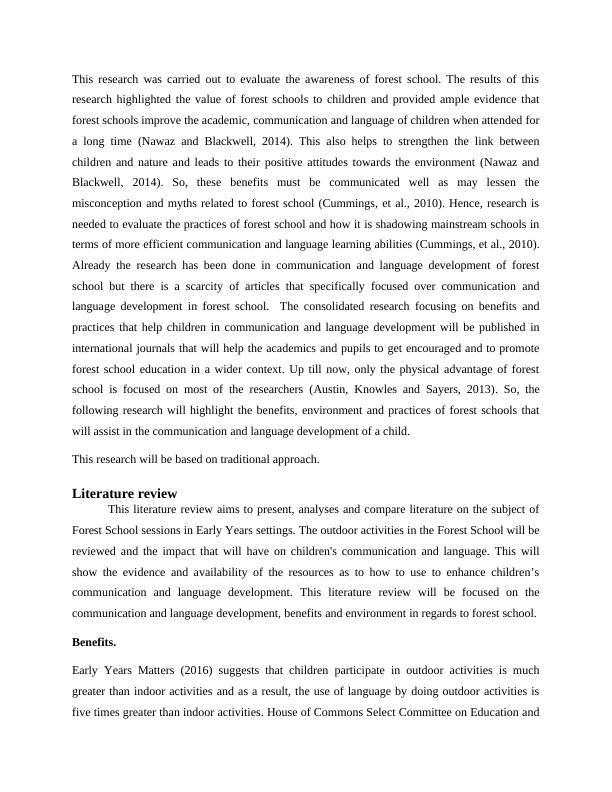
Skills (2005) confirmed the Forest school method adopted by some schools was remarkable and
provided children hands-on learning in the natural environment. Knight (2011) acknowledges
that Forest School provides many opportunities for teamwork, which can support children’s
communication skills, particularly if the child often struggles to work with others. O’Brien
(2009) suggested that the teachers were interviewed and they describe the Forest School
experience as being of great benefit to the children who take part. This will make children
confident and independent to socialize with others by sharing their feelings and thoughts
regarding the activities. O’Brien and Weldon (2007) also recognise that various schools in the
United Kingdom emphasize while sharing, helping others and comforting others where social
skills are present. Nevertheless, in the Murray and O’Brien report (2005) the benefits to
communication and language in social contexts are established. As a result, Ridgers et al.,
(2012) note that Forest school sessions provide opportunities for children to participate in
activities such as constructing shelters, using campfires, using real-life resources an identifying
different wildlife area. Vygotsky also mentioned through the Zone of Approximal Development
that children’s learning cannot be extended by themselves as they are most likely to achieve the
goals with the support of an adult. As a result, with the support of an adult, they will be able to
accomplish their goals and they will help children to pronounce properly and help them to
enhance their vocabulary (Basawapatna, et al., 2013).
Pioneers like Froebel and Pestalozzi have pointed to the importance of play in children's
development (Samuelsson and Pramling, 2014). However, McMillan’s open-air nursery school,
for example, was centered on a carefully designed garden in which children were encouraged to
make use of the wide range of resources and equipment including authentic tools: this was a
natural, real-life environment (Grenier, 2017). As they use natural materials as sensory play in
describing and storytelling activities by using fresh and dried flowers, rice, plastic bottles, pasta,
sand, stones, leaves, branches and fresh vegetables by describing how they look, feel and smell
to enhance children’s learning (Harris, 2015). These opportunities will be helped them to
frequently use familiar words, explore new concepts and expand vocabulary in a real sense
outside the classroom. This context did not include traditional reading and writing teachings
although some of the kids often used large sticks to make marks in mud and soil.
provided children hands-on learning in the natural environment. Knight (2011) acknowledges
that Forest School provides many opportunities for teamwork, which can support children’s
communication skills, particularly if the child often struggles to work with others. O’Brien
(2009) suggested that the teachers were interviewed and they describe the Forest School
experience as being of great benefit to the children who take part. This will make children
confident and independent to socialize with others by sharing their feelings and thoughts
regarding the activities. O’Brien and Weldon (2007) also recognise that various schools in the
United Kingdom emphasize while sharing, helping others and comforting others where social
skills are present. Nevertheless, in the Murray and O’Brien report (2005) the benefits to
communication and language in social contexts are established. As a result, Ridgers et al.,
(2012) note that Forest school sessions provide opportunities for children to participate in
activities such as constructing shelters, using campfires, using real-life resources an identifying
different wildlife area. Vygotsky also mentioned through the Zone of Approximal Development
that children’s learning cannot be extended by themselves as they are most likely to achieve the
goals with the support of an adult. As a result, with the support of an adult, they will be able to
accomplish their goals and they will help children to pronounce properly and help them to
enhance their vocabulary (Basawapatna, et al., 2013).
Pioneers like Froebel and Pestalozzi have pointed to the importance of play in children's
development (Samuelsson and Pramling, 2014). However, McMillan’s open-air nursery school,
for example, was centered on a carefully designed garden in which children were encouraged to
make use of the wide range of resources and equipment including authentic tools: this was a
natural, real-life environment (Grenier, 2017). As they use natural materials as sensory play in
describing and storytelling activities by using fresh and dried flowers, rice, plastic bottles, pasta,
sand, stones, leaves, branches and fresh vegetables by describing how they look, feel and smell
to enhance children’s learning (Harris, 2015). These opportunities will be helped them to
frequently use familiar words, explore new concepts and expand vocabulary in a real sense
outside the classroom. This context did not include traditional reading and writing teachings
although some of the kids often used large sticks to make marks in mud and soil.
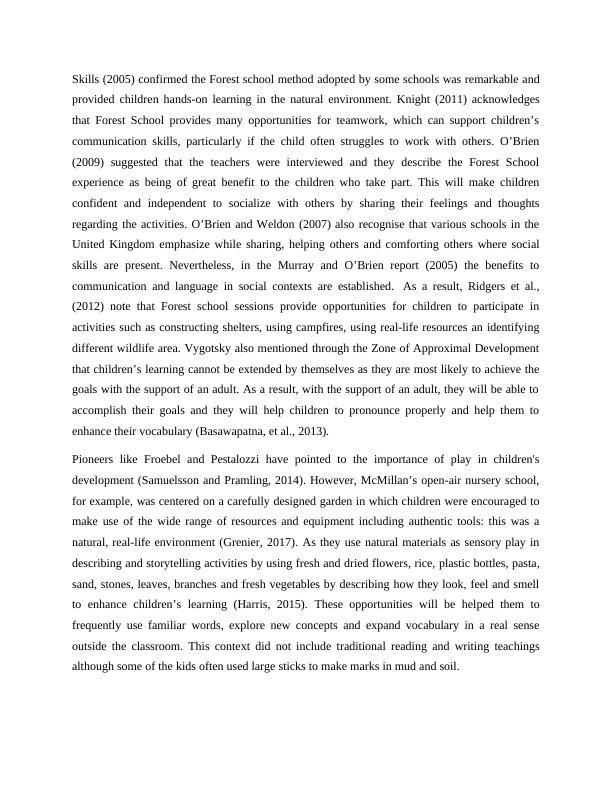
As a result, Children's experiences in nature are related to types of learning constructivist,
Waldorf, and Reggio-Emilia, which emphasise that children learn better by having direct
experiences rather than just being taught by an adult, thus allowing them to play freely and
helping them learn new words and understand the importance of nature(Arseven, 2014).
Children's experiences with nature are linked to forms of constructivist learning, Waldorf, and
Reggio-Emilia, which emphasise that children learn best by getting direct experiences rather than
only being taught by an adult, thereby allowing them the ability to play freely and help them
learn new vocabulary and appreciate nature's meaning, ensuring language was meaningful
(Arseven, 2014). Children learn more through online teaching and by technology-based devices,
such as audiobooks and child-friendly apps (Edwards, 2016). However, Forest School
opportunities enabled them to use the familiar language regularly, to revisit new concepts and to
extend vocabulary beyond the classroom in a real context (Constable, 2017).
Environment:
The outdoor environment was characterised as a unique setting for instruction to build up
children’s communication and language development to explore their surroundings. Teachers
and teaching assistants should be interested as much as they want to support children while they
are playing. This could be a rare opportunity to just stand back and enjoy seeing the children in a
natural environment or to observe individual child while they are playing. As a result, Chomsky
believed that children are born to inherited learning language through play as he believes every
child has a language acquisition device and children have to learn new vocabulary through
experience or play (Da Cruz, 2015). To facilitate this, forest schools provide sufficient
opportunities for children in the area to learn practical conversational skills, learn discussion of
interests / activities, promote social talk such as negotiation and planning, develop basic
vocabulary for the natural world such as names of animals / tools, etc. However, increased use of
digital technology in schools nowadays is making children depend on digital learning more than
physical experience; therefore, forest school environment will help change the current practices
as forest school’s curriculum is children-led and play-based. Alongside traditional forms of
schooling, forest school may provide children with the opportunity to transfer their skills into
daily life. The emphasis is on reconnecting children with their local outdoor setting, allowing
them the freedom to discover, play, explore and learn in a real, outdoor setting. Forest School
Waldorf, and Reggio-Emilia, which emphasise that children learn better by having direct
experiences rather than just being taught by an adult, thus allowing them to play freely and
helping them learn new words and understand the importance of nature(Arseven, 2014).
Children's experiences with nature are linked to forms of constructivist learning, Waldorf, and
Reggio-Emilia, which emphasise that children learn best by getting direct experiences rather than
only being taught by an adult, thereby allowing them the ability to play freely and help them
learn new vocabulary and appreciate nature's meaning, ensuring language was meaningful
(Arseven, 2014). Children learn more through online teaching and by technology-based devices,
such as audiobooks and child-friendly apps (Edwards, 2016). However, Forest School
opportunities enabled them to use the familiar language regularly, to revisit new concepts and to
extend vocabulary beyond the classroom in a real context (Constable, 2017).
Environment:
The outdoor environment was characterised as a unique setting for instruction to build up
children’s communication and language development to explore their surroundings. Teachers
and teaching assistants should be interested as much as they want to support children while they
are playing. This could be a rare opportunity to just stand back and enjoy seeing the children in a
natural environment or to observe individual child while they are playing. As a result, Chomsky
believed that children are born to inherited learning language through play as he believes every
child has a language acquisition device and children have to learn new vocabulary through
experience or play (Da Cruz, 2015). To facilitate this, forest schools provide sufficient
opportunities for children in the area to learn practical conversational skills, learn discussion of
interests / activities, promote social talk such as negotiation and planning, develop basic
vocabulary for the natural world such as names of animals / tools, etc. However, increased use of
digital technology in schools nowadays is making children depend on digital learning more than
physical experience; therefore, forest school environment will help change the current practices
as forest school’s curriculum is children-led and play-based. Alongside traditional forms of
schooling, forest school may provide children with the opportunity to transfer their skills into
daily life. The emphasis is on reconnecting children with their local outdoor setting, allowing
them the freedom to discover, play, explore and learn in a real, outdoor setting. Forest School
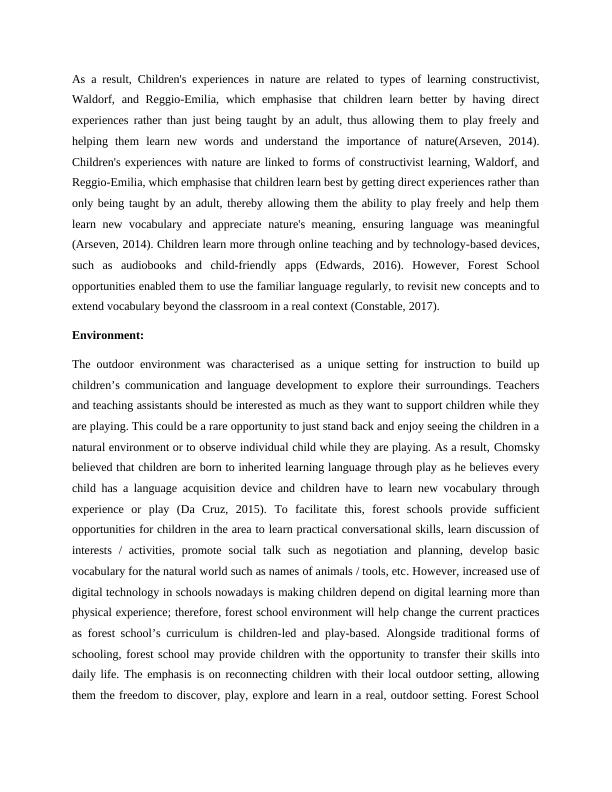
can be used for children of all ages; traditional and children for specific special needs. Children
who are not known to focus well in class are encourage to come to forest school and excel in
practical/hands-on activities. Better social skills, greater peer participation, improved
relationships and better problem-solving skills all help forest school participants. At Forest
School, no child can fail; they all try to take something good or new from the experience. As
outdoor play provides many opportunities towards sensory play that cannot be acceptable in the
indoor environment, such as children will get the opportunity to run, freedom to scream, be
messy, feel the freash breeze, feel the heat of the sun and cold of the snow (Duarte and Freeman,
2017). These sensory experiences are essential for their growth and development and for their
imagination stress (Pinto, Pessanha and Aguiar, 2013).
Early Years Outdoors (2009) acknowledge that some children’s communication and language
increase by outdoors playing. Early Years Outdoors (2016) indicate that this is because of
providing them with the outdoor space and independence. In contrast, children have to adhere to
rules and regulations that apply indoor, such as certain levels of noise and that does not apply
during forest school activities. The Theory of Froebel (1887) explores how the child learned and
get motivated through the play. Adults disrupt the play and learning of children by being too
dominant. Tassoni and Hucker (2000) it provides clinicians with an opportunity to develop many
ways to improve the social communication skills of the children. So this involves children's play
practitioners to promote dialogue and provide children with the tools and learning environment
to communicate with each other.
Similarly, Montessori's approach to child-driven portrays adults as facilitators, providing
children with the resources and atmosphere to support their learning (Isaacs, 2018). Miller et al.
(2005) it also explores the influences of children's learning environment and indicates that the
numerous tools, events and structures within that environment can have an impact on holistic
learning and growth for children. However, O'Brien (2009) indicates that children ought to be
more interested in the natural environment because it positively influences holistic learning.
Murray and O'Brien (2005) have put emphasis that the forest school style sessions and outdoor
learning require less parental involvement and activities led by adults, thereby promoting
independence and well-being for children. In comparison, Bruce (2005) recognises that the
supply of material is essential to an effective learning environment and that the materials
who are not known to focus well in class are encourage to come to forest school and excel in
practical/hands-on activities. Better social skills, greater peer participation, improved
relationships and better problem-solving skills all help forest school participants. At Forest
School, no child can fail; they all try to take something good or new from the experience. As
outdoor play provides many opportunities towards sensory play that cannot be acceptable in the
indoor environment, such as children will get the opportunity to run, freedom to scream, be
messy, feel the freash breeze, feel the heat of the sun and cold of the snow (Duarte and Freeman,
2017). These sensory experiences are essential for their growth and development and for their
imagination stress (Pinto, Pessanha and Aguiar, 2013).
Early Years Outdoors (2009) acknowledge that some children’s communication and language
increase by outdoors playing. Early Years Outdoors (2016) indicate that this is because of
providing them with the outdoor space and independence. In contrast, children have to adhere to
rules and regulations that apply indoor, such as certain levels of noise and that does not apply
during forest school activities. The Theory of Froebel (1887) explores how the child learned and
get motivated through the play. Adults disrupt the play and learning of children by being too
dominant. Tassoni and Hucker (2000) it provides clinicians with an opportunity to develop many
ways to improve the social communication skills of the children. So this involves children's play
practitioners to promote dialogue and provide children with the tools and learning environment
to communicate with each other.
Similarly, Montessori's approach to child-driven portrays adults as facilitators, providing
children with the resources and atmosphere to support their learning (Isaacs, 2018). Miller et al.
(2005) it also explores the influences of children's learning environment and indicates that the
numerous tools, events and structures within that environment can have an impact on holistic
learning and growth for children. However, O'Brien (2009) indicates that children ought to be
more interested in the natural environment because it positively influences holistic learning.
Murray and O'Brien (2005) have put emphasis that the forest school style sessions and outdoor
learning require less parental involvement and activities led by adults, thereby promoting
independence and well-being for children. In comparison, Bruce (2005) recognises that the
supply of material is essential to an effective learning environment and that the materials
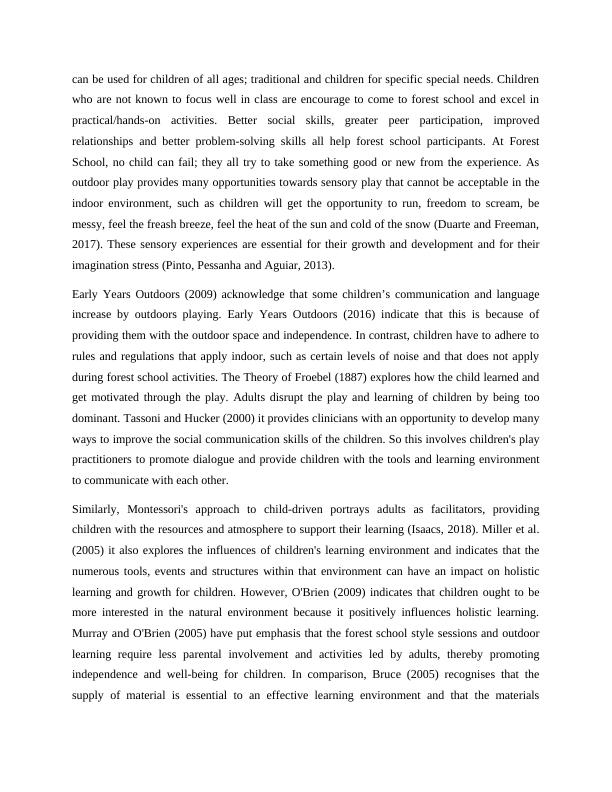
End of preview
Want to access all the pages? Upload your documents or become a member.
Related Documents
Guidance Approach to Teaching: Creating a Nurturing Environment for Early Childhood Developmentlg...
|4
|778
|204
Enhancing Literacy and Language Development in Preschool Childrenlg...
|9
|2550
|239
Child Development: Patterns, Learning, Transitions and Factorslg...
|12
|3681
|229
Language and Literacy for Early Childhood PDFlg...
|13
|3651
|520
Collaboration between Schools and Parents of Autistic Childrenlg...
|8
|2533
|50
Classroom Managementlg...
|8
|1866
|54
